Snitterfield Tennis Club is a small club situated in the heart of Warwickshire and is located approximately four miles from both Stratf ord upon Avon and Warwick.
The club is part of the Snitterfield sports club and is represented in local tennis leagues. The club offers coaching for all age groups and abilities.
It has three floodlit courts, two of which had previously been surfaced with Playrite’s Matchplay 2 ITF category 3 pace rated sand-dressed synthetic surface.
At the turn of the year, the club made a decision, due to the popularity and playing demand on the existing Matchplay 2 Courts, to upgrade the remaining hard court to the same
surface.
The high-performance hard-wearing nature coupled with the low maintenance aspect of the surface was key to the clubs’ decision to once again choose Matchplay 2.
Fosse Contracts Ltd, whom Playrite have worked with on numerous tennis projects over a number of years, were chosen as the contractor and the new Playrite Matchplay 2 surface was installed in April 2018 in a two tone green colour scheme to compliment the other courts.
All three Matchplay 2 courts are floodlit and open for use and team hire all year round.
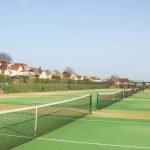
Playrite’s Matchwinner Velour synthetic surface is an ideal product for creating these Primary spaces; bright and vivid colours incorporated into a highly durable and strong material fit the bill perfectly. With limited space and the need to provide a surface for a number of sports, Matchwinner Velour is an ideal alternative to the standard wetpour installations. Matchwinner Velour is available in 14 different colours and has great playing characteristics for many different ball games including football, hockey, tennis, netball, basketball and rounders… The possibilities are endless, as is the fun!
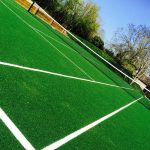
Grandplay is an outdoor, all weather tufted surface accredited to ITF 4, medium fast, a brilliant choice for any school or tennis club with a range of abilities.
This unique structured surface boasts unrivalled durability and performance, assisting with foot grip and turn and giving a great bounce to the ball. A brilliant low maintenance, sand dressed surface available in green with white lines to mark the court area.
This new addition to the Playrite family complements our existing tennis surfaces whilst being able to offer our customers something new.
We are now able to offer tennis clubs a surface for any style of play and across all ITF pace ratings:
Matchclay – ITF pace 1 Slow
Clayrite – ITF 2 Medium slow
Matchplay 2 – ITF 3 Medium
Grandplay – ITF 4 Medium fast
Winner 15 – ITF 5 – Fast
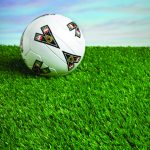
Recently, there’s been a lot of conversation around 4G, 5G and even 6G surfaces, raising questions of the actual state of sport surfacing technology: what makes these surfaces different? What effect do they have on the playing experience? Where can I find them?
The best way to answer these questions is to start from the beginning – or at least as far back as 3G surfaces, since 1G and 2G are terms that were applied retrospectively, referring to the very first artificial sports surfaces.
The past five decades have seen significant developments in synthetic sports surfaces, with the very first artificial pitch, AstroTurf, kick-starting an industry that is now rife with fresh new designs and innovative manufacturing techniques. Recently, there’s been a lot of conversation around 4G, 5G and even 6G surfaces, raising questions of the actual state of sport surfacing technology: what makes these surfaces different? What effect do they have on the playing experience? Where can I find them?
The best way to answer these questions is to start from the beginning — or at least as far back as 3G surfaces, since 1G and 2G are terms that were applied retrospectively, referring to the very first artificial sports surfaces.
3G means 3rd Generation, an innovative sports surface that utilises synthetic materials to replicate the look, feel and playing experience of natural grass. 3G turf is supported by an infill of sand and rubber, providing maximum comfort and excellent ball performance (this performance is heightened when used with a shock pad, which also contributes to durability). 3G surfaces should be offered in a range of pile heights which can be matched to your requirements, ensuring you’ve got the right surface for your sport.
So if that’s a 3G sports surface, what about 4G? Well, the truth of the matter is that 4G surfaces don’t actually exist.
Some artificial sports surface manufacturers, stockists and installers refer to their products as 4G as they believe them to be a step up in artificial surfacing technology. However, no surface has yet received approval from sports governing bodies including FIFA and IATS. In short, 4G is a marketing tool that brands use to assert themselves as industry leaders. However, while the world of sports surfaces sees technological advancements on a regular basis, we’re yet to see official accreditation.
There’s a lot of confusion surrounding progression of artificial surfaces, but here at Playrite we can confidently say that our 3rd Generation products are the ultimate in sports surfacing. Read more about our artificial 3G surfaces, and remember to get in touch with one of our experts who can answer your questions.

Tennis courts come in a variety of surfaces, each bringing its own set of dynamics to the game. The surface influences not only the pace of play but also the style and strategy that players adopt. From the hard and fast to the soft and slow, let’s dive into the details of each surface type.
There are four primary types of tennis court surfaces: Hard, Clay, Grass, and Artificial surface. Each surface presents distinct challenges and advantages, impacting how the game is played. Let’s explore each one in detail.
Hard courts are the most common type of tennis court surface, often seen in public parks and professional tournaments alike.
Made from rigid materials like asphalt or concrete, hard courts are usually coated with an acrylic layer that provides a uniform and durable playing surface. The court is typically medium-paced, offering a balance between the slow play of clay and the rapid pace of grass courts. Hard courts provide a consistent bounce, making them favourable for players who rely on strong serves and precise groundstrokes. However, the surface is unforgiving on the body, often leading to increased wear and tear, particularly on the joints
Hard courts are highly popular due to their low maintenance costs and versatility. They’re found in various settings, from local community centres to grand slam tournaments. Because of their consistency, they are often the preferred surface for many tennis events and training sessions.
The two most famous hard court tournaments are the Australian Open and the US Open. These events showcase the intense speed and precision that hard courts bring to the game, often favouring players with powerful serves and solid baseline play.
Clay tennis courts are often associated with slower, more strategic play, requiring patience and endurance from players.
Clay courts are made from crushed shale, stone, or brick. These materials create a soft, loose surface that slows down the ball and makes it bounce higher. This type of court favours baseline players who excel in long rallies. The soft surface is also gentler on the body, reducing the risk of injuries like sprains or stress fractures. However, the loose material can shift during play, leading to variable bounce and the need for regular maintenance.
Clay courts reward players with excellent footwork, endurance, and a strategic mindset. The slower pace gives players more time to react, making it easier to construct points and outmanoeuvre opponents. Sliding into shots is a common tactic on clay, requiring good balance and technique.
The most renowned clay court tournament is the French Open, held at Roland Garros in Paris. Known for its challenging conditions, the French Open has produced some of the most legendary matches in tennis history, often favouring players with exceptional stamina and tactical skill.
Grass courts are the original tennis surface, offering a fast-paced, low-bounce game that contrasts sharply with clay.
Grass courts are made from natural grass, which is cut short to create a smooth, fast-playing surface. The grass surface offers the least friction of all court types, resulting in a low bounce and quicker ball movement. This type of court favours players with strong serves and volleys, allowing them to dominate with quick, aggressive play. However, grass courts are highly susceptible to weather conditions and require extensive maintenance, including regular mowing, watering, and patching.
The variability of the grass surface can lead to unpredictable bounces, making it challenging for players to anticipate shots. Additionally, grass courts are sensitive to rain and wear, which can quickly degrade the playing surface and affect the quality of the match.
Wimbledon is the most famous grass court tournament, known as the oldest and most prestigious tennis championship in the world. The fast-paced nature of grass courts at Wimbledon has given rise to many iconic moments in tennis, favouring players with aggressive, serve-and-volley styles.
Artificial turf courts are less common but offer a unique playing experience that combines elements of both grass and hard courts.
Made from synthetic fibres that mimic the look and feel of natural grass, artificial turf courts offer a durable surface often filled with sand or rubber to provide cushioning. This results in a medium-paced court with consistent bounce. Due to its lower maintenance needs compared to natural grass, artificial surfaces are a more popular choice, particularly in regions with extreme weather conditions where grass courts would be impractical.
Artificial turf offers a good compromise between the speed of hard courts and the softness of grass courts. It provides a consistent playing surface that is easier on the joints, making it suitable for players of all ages and skill levels. Additionally, artificial turf courts are less affected by weather, providing a reliable surface for year-round play.
Often used in recreational settings like sports clubs and schools, artificial surfaces are favoured for their durability and low maintenance requirements. They’re particularly popular in regions with harsh climates where maintaining natural grass is challenging.
The surface of a tennis court can dramatically influence the way a match is played. From the speed of the game to the bounce of the ball, and even the physical demands on the player, each surface brings its own unique challenges and opportunities.
The speed of play is one of the most noticeable differences between court surfaces. Hard courts typically offer medium-fast speed, grass courts are the fastest, and clay courts are the slowest. Artificial turf usually sits somewhere in between. Players must adapt their strategies to the pace of the surface to gain an edge over their opponents.
Ball bounce varies significantly across different surfaces. Hard courts provide a predictable, consistent bounce, while grass courts offer a lower, faster bounce that can be more challenging to read. On clay courts, the ball tends to bounce higher and slower, allowing more time for players to set up their shots. Artificial turf courts typically offer a consistent bounce, similar to hard courts but slightly softer.
Each surface type places different physical demands on players. Hard courts, with their unforgiving nature, can be tough on the joints, especially during long matches. Clay courts are easier on the body but require excellent endurance due to the lengthier rallies. Grass courts can lead to quicker matches but demand agility and quick reflexes, whilst artificial surfaces offer a balance, being easier on the body while still providing a fast-paced game.
If you would like any advice or guidance on choosing the perfect tennis court surface feel free visit our contact us page or call us on 01924 412 488.
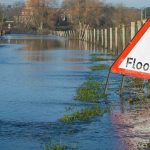
Even though the water may have subsided, many hazards will still remain which you’ll need to take into consideration to keep your staff, volunteers, members and general public safe.
A planned approach to clean up is required to maintain safety and the long term use of the facility. First thing is to contact your insurance company – do not remove anything from site until you have done this.
Secondly take advice from a specialist sports surface consultant to establish if the surface can be rejuvenated or if a new surface is required. You should be careful to wash the sediment off the surface and remove in accordance with the manufacturer’s instructions. Do not wash the sediment into the pile or into perimeter drains as this will block drainage.
Heavily affected artificial sports surfaces should be cleaned using specialist equipment by specialist cleaning contractors. The equipment should combine brushed with air or water to clean the surface and any infill to remove the sediment. If the worst comes to the worst contact your manufacturer who would be able to advise on overlaying the existing ground work.
For future reference:
· Develop a club flood plan
· Look at a flood resilient design
· Plan ahead
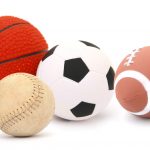
Sports surfaces must be durable and functional. Unless you have unlimited resources for maintenance, real grass often doesn’t meet expectations. In some cases, this can impact the quality of the sport.
Here’s our guide to playing sports on artificial turf:
Football
Artificial grass for football has come a long way in the past 20 years. The 3G pitches available today are nothing like the sandy, rough turf used in the 1990s.
They’re filled with rubber crumb, which is a combination of sand and rubber granules. This provides a more comfortable experience for the player and improves ball control.
The pile (blades of artificial grass) is longer in the 3G pitches too, making this new style of turf much more realistic. It resembles real grass, both in appearance and functionality. You can even wear studded boots on the pitch, which improves grip significantly. This, along with the rubber crumb, reduces the risk of grazed knees encountered with the old style of synthetic pitch.
There’s plenty of choice when it comes to artificial turf for football. For the best playing experience, we recommend a pile length between 40 and 60mm.
Rugby
The development of 3G pitches has also revolutionised the use of artificial grass for rugby, with many professional teams choosing them over real grass.
A rugby pitch needs to be durable. It must be able to withstand repeated impact, especially in high traffic areas. With real grass, this is a challenge — particularly during the wet, winter months.
Artificial turf improves safety and performance, providing a comfortable playing experience, whatever the weather.
Tennis
The British weather also represents a real challenge for tennis clubs. During summer, unpredictable rainfall continues to disrupt matches on even the most well-maintained courts.
If you need sports surfaces to increase playing time, artificial grass is the answer. Outdoor courts enable play to continue as little as 30 minutes after the rain stops, with indoor courts available for year-round use.
Artificial tennis courts have a shorter pile length than 3G pitches, ensuring optimal ball control. A range of options are available, to suit varying abilities and styles of play.
Hockey
Hockey was one of the first sports to embrace synthetic sports surfaces. The majority of professional games are now played on an artificial pitch.
The playing surface has a direct influence on the quality of play, so this should always be a priority. We recommend a short pile, or needlepunch surface, to optimise ball control, bounce, speed and safety
Cricket
Finding the right sports surface for cricket can be a challenge, but it’s not impossible. It’s important to ensure the artificial turf is non-directional and durable, especially in the high traffic areas of the pitch.
For this reason, woven surfaces are the best choice. They’re extremely durable, and perform well under tension for long periods. If you have a limited budget, needlepunch surfaces over the next best solution, providing a balance between cost and resilience.
We rarely recommend tufted surfaces for cricket. These tend to be mass produced products, and often fail to provide the desired results in terms of longevity.
Bowls
If you’re looking for an artificial turf to use on a bowling green, you must carefully consider the materials used. Just like cricket, a non-directional surface is required. For bowls, the artificial grass must also provide consistent green speeds.
Bowling greens that use real grass are notoriously difficult to maintain, and costs to employ groundsmen are high. Maintenance of artificial grass is much less time-consuming, and consequently more cost-effective for the majority of bowls clubs.
Indoor bowling greens are also available, providing a place for you to play all year round.
Golf
Artificial grass can also be used to reduce maintenance cost for high-impact sections of the golf course. Typically, the areas surround the tees and putting greens are the hardest to maintain, as they endure the most wear and tear.
Artificial turf can be used in these areas to provide a resilient and cost-effective solution. A range of options are available to provide a realistic finish, with varying pile heights to suit different areas of the course.
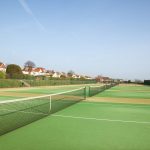
You also need to consider what else the court will be used for. Although many courts are used solely for tennis, they can also be installed as part of a MUGA installation (Multi Use Games Area) which are increasingly popular with schools and public sports facilities.
The most expensive type of tennis courts range in cost from £50,000-£60,000, but because there are so many options to consider, the price can vary greatly. Natural grass and clay tennis courts are among the most expensive to install and maintain, with cement courts somewhat cheaper to build and significantly cheaper to maintain.
However, in recent years, synthetic grass and artificial clay court surfaces have improved significantly in quality and are now a viable alternative to natural courts, offering significantly lower maintenance costs.
As well as being cheaper to install, artificial courts can be used more regularly and are easier and cheaper to maintain. Synthetic surfaces can now replicate the feel of grass, clay and cement courts, and synthetic courts were already very popular for indoor courts.
Although synthetic courts still require some maintenance, this is considerably less than the equivalent natural court. For example if the courts use a sand or clay infill, this may have to be added and the surface should be brushed on a regular basis.
Our artificial surfaces have the highest UV stabiliser available that will protect against UV rays and prolong the life of the surface.
Many people can’t understand why a tennis court could be so expensive to install – it is after all a small area of flat ground. However, there are many complications that need to be taken into account with a tennis court installation project. Here are some of the main factors that can directly influence the cost of installing a court:
Whilst laying a driveway or surfacing a car park might look simple, a tennis court is another matter altogether. The preparation work for a new surface is considerable, with tennis court installations taking weeks rather than days. The site first needs to be cleared – the cost and complexity of this will vary, depending on what is currently on the site.
Proper drainage is then required to ensure that the court can be used as soon as possible after rain, and the surface itself must remain totally flat for many years, as any imperfections could affect play. So, a sub-layer is required below the playing surface, to allow proper drainage of the court.
Tennis court installation projects can also be very complicated logistically. Because most courts are installed at sports clubs or in very large gardens, the site is normally quite a distance from the nearest road. As well as transport costs, large amounts of materials need to be moved very carefully within the site itself, adding even further to construction costs and lead times.
Finally, once the groundwork is done, it is time to choose the playing surface. Traditionally, the choices consisted of cement, grass and clay. However, as synthetic surfaces have improved to the point that they now produce a playing experience very close to those of real courts these surfaces have grown rapidly in popularity.
They are considerably cheaper to maintain, and in the case of synthetic grass courts, can be used all year round, whereas real grass courts may need to be left for the playing surface to grow back following periods of heavy use.
Depending on the nature of the installation, there are still many optional extras that can add further to the cost of a court. All courts will of course need a net, and the posts need to be mounted firmly and positioned very precisely. Other options might include fences, floodlights, seating or even water fountains if the court is being installed at a private tennis club.
You can now see why the costs of installing a tennis court are so significant, and why artificial tennis courts are growing so rapidly in popularity.
If you would like to discuss a tennis court project, contact us through the website, or call us on 01924 412488 and our experts will be happy to assist you.

What’s more, in recent years a big factor in the growth of artificial pitch installations has been the great advances in the realistic feel and playing characteristics of such surfaces.
So, with more and more clubs, schools and other organisations choosing to install artificial sports surfaces, what do you need to consider before getting quotes for the project?
Before your new surface can be laid, you need to consider what is already there and how you will get the area ready for your new surface. Many installations involve replacing a natural grass or concrete surface, but because artificial pitches have been around for some years now, some involve replacing a previous artificial surface.
In some instances, it can be realistic to overlay a surface straight over an existing one. However, although this can help keep costs down, it is not always practical or suitable. Newer sports surfaces are also designed to higher standards of specification, so for example the existing pitch may not have the right standard of drainage that the new surface will require. An installer will be able to assess your current surface and advise on the best way to install a new one.
The list of sports that can realistically be played on an artificial surface has grown significantly in recent years. For tennis – which is played on several different natural surfaces – there are now artificial equivalents for grass, clay and cement as well as indoor.
The technological advancements combined with cost pressures on sporting organisations have fueled the growth of MUGAs (Multi Use Games Areas) which allow for several sports to be played on one surface.
You should consider:
There simply is no surface that will be suitable for all sports. For example, tennis cricket and hockey all require a short ‘pile height’ to allow for fast movement of the ball, whereas football and rugby need to allow for collision and impact and help minimise injuries.
Although maintenance of an artificial sports pitch can be cheaper and easier than that of a natural one, some work is still required to keep the surface performing at its best. You should consider who is available to maintain the pitch over its lifespan.
The manufacturer or installer will be able to advise on the equipment, materials and frequency required to maintain your artificial pitch and maximise its longevity. From there you need to either devise a maintenance plan that your organisation can keep to or consider external resources to maintain your pitch or surface.
Finally, you should consider how long you realistically want and expect the surface to last. This will depend to a great extent on the budget and how the project is being financed. If for example a surface needs to be financed over 10 years, the organisation will need it to last for at least that long to ensure that they can afford to pay for a replacement after that period.
Once you know this, you will have all of the key information you need. The final decision is simply a matter of balancing the different needs the organisation has for the surface with the budget and resources available. If this is done right, there is no reason that the users of your surface shouldn’t enjoy many years of realistic play from your surface.
Contact us if you are looking to install an artificial sports surface and need help with any of these aspects of your project. We’ve been creating high-quality sports surfaces for many years and are well-placed to help you find the right one for your needs.